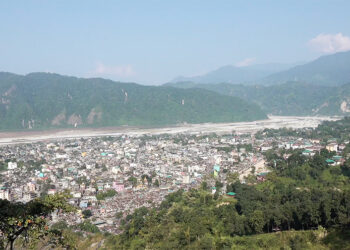 A new venture is bubbling beneath the surface. Welcome to the country’s first crawfish farm, promising a fresh twist to local aquaculture. Crawfish Himalayan Limited, a foreign direct investment company in Phuentshogling, is preparing to bring crawfish to both domestic and international markets.
A new venture is bubbling beneath the surface. Welcome to the country’s first crawfish farm, promising a fresh twist to local aquaculture. Crawfish Himalayan Limited, a foreign direct investment company in Phuentshogling, is preparing to bring crawfish to both domestic and international markets.
Crawfish are small freshwater crustaceans that look like tiny lobsters. They live in rivers and ponds and are often caught or farmed for food. Crawfish are popular in many dishes and are known for their sweet, tender meat.
And that delicacy is now in town.
The Crawfish farm spans 24 acres.
 Fries or young crawfish that have just hatched are kept in these blue nursery trays. There are 1500 such trays. The company expects to produce 50,000 fries in a day.
Fries or young crawfish that have just hatched are kept in these blue nursery trays. There are 1500 such trays. The company expects to produce 50,000 fries in a day.
Kushal Chhetri, the general manager of Crawfish Himalayan Limited said, “We are developing a state-of-the-art hatchery to breed and cultivate Cherax quadricarinatus, one of the most sought-after crawfish species globally. Known for its high market value and strong international demand, this species presents a significant opportunity for sustainable aquaculture.”
 Young ones are kept in the hatchery for one month before they are moved to grow-out ponds.
Young ones are kept in the hatchery for one month before they are moved to grow-out ponds.
“Once the hatchery is operational and we have secured the broodstock, the plan is to begin producing fry, young crawfish. These will be hatched in the hatchery and raised there for about a month. Once they are mature enough, they will be transferred to the ponds for further growth,” said Roshan Sharma, the CEO of Crawfish Himalayan Limited.
These are grow-out ponds. As the name suggests, this is where young crawfish are raised until they reach the market size in four months. Here, they have space to grow in a natural-like environment before they are harvested.
Kushal Chhetri added, “Currently, we have completed building around 15 ponds here. Two of which serve as a reservoir, the 13 others serve as grow-out ponds. Here we have the state-of-the-art flash system, a recirculatory aquaculture system.”
The recirculatory aquaculture system is a technology used in fish or crawfish farming where water is continuously filtered, cleaned, and reused within the system.
With technical expertise from Singapore Crawfish Limited, they are adopting sustainable, modern aquaculture practices to produce healthy, disease-free crawfish.
The company’s larger vision goes beyond commercial farming. Crawfish Himalayan Limited aims to support Bhutan’s food security by partnering with local farmers.
Roshan Sharma said, “This also aligns with the government’s vision to open up the agri-sector to FDIs. The second objective is also to change the dietary habits of our Bhutanese since crawfish is highly nutritious. We also look into its export potential because the crawfish has a high demand globally, specifically in Europe and China.”
The company is also exploring integrated farming methods, such as cultivating paddy along with crawfish.
“If we can successfully combine rice and crawfish farming, there is evidence, such as studies from China, showing that farmers have increased their income by nearly three to four times using the same land area. This integrated approach is something we plan to explore in the future. For now, however, our focus is on establishing whether crawfish can be sustainably cultivated in our local environment here in Bhutan, specifically in ponds,” said Roshan Sharma.
Once fully operational, the company expects to produce up to 1.6 tonnes of crawfish every day, equal to the weight of a small car.
The company was established in early 2023, and hatchery construction began early last year.
With its modern approach and strong market potential, crawfish farming could open new income streams for farmers and mark a fresh chapter in Bhutan’s aquaculture journey.
Devika Pradhan & Kinley Dem
Edited by Tandin Phuntsho








